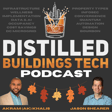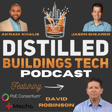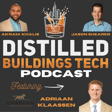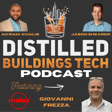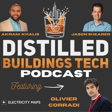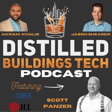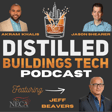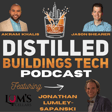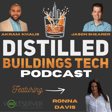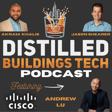Become a Creator today!Start creating today - Share your story with the world!
Start for free
00:00:00
00:00:01

Mahmoud Ibrahim on Fault Managed Power and the Future of Smart Building Electrification
🔥 Episode Summary
In this episode, Jason and AK sit down with Mahmoud Ibrahim, Senior Product Director at Panduit, to explore how Fault Managed Power (FMP) is transforming power delivery in smart buildings.
With a background in mechanical engineering and a passion for business, Mahmoud shares his journey from R&D to leading FMP at Panduit—making “dumb power smart” by enabling higher voltage delivery over thinner cables while continuously monitoring for faults like shock, arc, or fire risk.
The discussion covers how FMP works alongside PoE, real-world use cases, evolving standards, workforce implications, and why this technology is the next evolution in safe, efficient building electrification.
🛠️ Topics Covered
- Mahmoud’s transition from engineering to product leadership
- What FMP is and how it enables long-distance, high-voltage power with built-in safety
- Comparison to GFCI: FMP detects multiple fault types, not just ground faults
- UL 1400 standards and cable requirements (450V-rated, multi-pair construction)
- How FMP complements PoE—“Trunk vs. Branch” analogy
- Real-world deployments in security, lighting, Wi-Fi, and DAS
- Education, healthcare, and campus retrofits as ideal FMP use cases
- 2026 NEC code updates introducing “Limited Energy” categories for PoE and FMP
- The FMP Alliance—uniting Cisco, Panduit, Belden, VoltServer, and others to drive adoption
- Vision for scaling FMP into EV charging, data centers, and industrial sectors
- ArcSafe benefits for mining, hazardous environments, and reducing fire risks
💡 Key Takeaways
- FMP makes electricity safer by turning off circuits instantly when faults are detected
- Runs power and data over shared pathways without traditional conduit
- PoE remains critical for data and device power, FMP brings scalable building-wide electrification
- Class 4 circuits remove power limits, focusing on energy safety, not wattage caps
- Industry-wide collaboration (FMP Alliance) is key for interoperability and global adoption
🥃 This Episode’s Drinks
- AK: Michter’s Rye, on the rocks
- Jason: Fast Old Fashioned with Rabbit Hole Rye, cocoa bitters, dehydrated orange garnish
🎧 Who Should Listen?
- Smart building technologists and consultants
- Contractors and low-voltage installers
- Real estate owners modernizing infrastructure
- Manufacturers exploring next-gen electrification
- Anyone interested in safer, scalable building power
📣 Connect & Follow
- Learn more about FMP: fmpalliance.org
- Panduit solutions: panduit.com
- Subscribe on Apple Podcasts, Spotify, or YouTube
- Follow Jason, AK, and Mahmoud on LinkedIn
Transcript
Introduction to Distilled Buildings Podcast
00:00:20
Speaker
All right, everybody. Welcome to the Distilled Buildings Technology Podcast. Where smart buildings are shaken, stirred, and data-driven. I'm your host, Jason Scheer. your host, AK.
00:00:32
Speaker
And welcome to the show. So ah what is in your glass today, aka I have the Michlers rye. Yep, Michlers is a solid choice for sure. Just on on on the rocks or neat.
00:00:48
Speaker
On the rocks and our favorite logo. Excellent.
00:00:52
Speaker
Good deal. So what do you got? So I've been I am a huge, obviously a huge bourbon fan. Love where have been on, you know, an old fashioned kick, but I've I've found this like fast old fashioned recipe.
00:01:06
Speaker
you know, the where you don't have to use, you mixing glass or anything like that. You can mix it right in, right in your rocks glass. So I just put, you know, a big rock in there, pour some, some rye, and rye whiskey, and then a little bit of simple syrup.
00:01:21
Speaker
And I found chocolate bitters, like cocoa bitters are just a really, really good compliment. And then instead of you know, getting a peeler out and, uh, you know, an orange, um, I have just been using these dehydrated, orange wheels and it makes a really, really nice looking cocktail.
00:01:40
Speaker
That just sounds delicious. Boring of okay. Just pour the rye into a glass, pour the rye into the glass with some ice and you're good to go. That's it. Cheers.
Exploring Rye Whiskey and Bourbon Trail
00:01:51
Speaker
Cheers.
00:01:51
Speaker
And my, um, I found this brewery out of um out of Louisville, Kentucky, Rabbit Hole. I'm drinking their Boxer Grail rye today.
00:02:04
Speaker
ah But it's, you know, like we see with a lot of distilleries, great, great couple of people that started it and just like a really, really good story around that. So I'm really tempted to deca to go on like a bourbon trail trip one of these one of these years. So we need to talk about that.
00:02:22
Speaker
That's definitely in in the works. yeah Definitely we're going to try to do it. Yeah, I mean, obviously I'd go for the bourbon, but the rye, it's just there's a taste sometimes and that's just trying to have some rye and that mixture, you can't really go wrong.
00:02:36
Speaker
Nope. Can't go wrong. And this is, uh, this rabbit hole is, you know, it's, uh, it's 95 proof, but it's like a 95% rye, 5%, malted barley. So it's, it definitely has a really, really good rye spice to it, you know, similar to ah a, bullet or something like that.
00:02:55
Speaker
Yeah. Mix it up.
Guest Introduction: Mahmoud Ibrahim
00:02:58
Speaker
cool. So I think off to the episode. So today we are having a chat with Mahmoud Ibrahim. He is a senior product director at Panduit on their fault managed power product. And this was previously recorded like live in Chicago at Panduit's headquarters. So enjoy the conversation.
00:03:20
Speaker
That's gonna be a lot of fun. alit I'll let you throw that apart. We're at Panduit Innovation Center. Cool, well so this week where ah we're with Mahmoud here at the Panduit Innovation Center in Tinley Park.
00:03:31
Speaker
um We're doing some you know some enablement some training around FMP or fall management power. So Mahmoud, do you want to tell us like a little bit about yourself and what you do at Panduit?
Career Path: Engineering to Product Management
00:03:41
Speaker
Yeah, absolutely. First, it's actually a pleasure to have you guys here visiting, hosting you.
00:03:45
Speaker
So my background is mechanical engineering. I graduated with a PhD, focused more on heat transfer fluid dynamics, so I had nothing to do with electricity for a while.
00:03:56
Speaker
That's what I did at Panduit in R&D, and then the past four or five years I've been involved in fault managed power. Wearing many hats, so started off be doing business development to figure out the product, where it's going to fit, doing a little bit of product management, now marketing, selling. So it's kind of like a startup within Panduit, so jack of all trades pretty much. That's awesome. How did she how you make that the leap? I'm always interested in my career arcs, like mechanical engineering, and that's what I studied as well. i How did you end up mechanical engineering to like electrical product management?
00:04:28
Speaker
I always wanted to be more on the business side of things. and I knew that that eventually I'm going to get there. and It's just opportunities within Panduit that's actually a nice thing about the company is things open up, so I started doing more business development things, like coming from an engineering angle.
00:04:46
Speaker
I've always been interested in doing my MBA, so got that done it about a a year ago now, after ah through Booth. It was a fantastic experience and so now I've kind of jumped over to the dark side.
Understanding FMP Technology
00:04:58
Speaker
let's Tell us about your world, what's FMP or what's Fault Managed Power to the audience that doesn't know that.
00:05:04
Speaker
Sure. Yeah, sorry, I've been probably using the acronym. Are you used to it? So, fault-managed power, it's like you, Jason, had said before, it's making dumb power smart. I really like that phrase. TM, TM. We're all doing it like royalty checks.
00:05:20
Speaker
But it really, that's that's really a big part of what it is. It's the way we run electricity today. I've just, I've not really been exposed to running circuits and and working with electrical circuits in the past. But just think about how it's done in in in our homes. You have to run cable through conduit, you have outlets, you have electricians installing that, that's yeah breaker panels to deal with, that's the traditional.
00:05:46
Speaker
Fault managed power is coming in to kind of disrupt that a little bit. where it's allowing you to deliver higher voltages over thinner copper gauges. you can go long distances, but the fault-managed piece is, it's actually constantly looking at the circuit to see if there is an actual fault or something that can cause a hazard like a fire or a shock to someone dealing with it. And if it does, then it just that the fault managed piece just turns that circuit on. So it's a very smart, if you think of it like a smart circuit breaker that can detect multiple types of fault, just basically making electricity safe.
00:06:22
Speaker
It sounds kind of kind of like kind like like an extension to, like a lot of us in our homes, we have those GSCI breakers in our bathrooms. It's kind of like an evolution or like gf GSCI on steroids. Absolutely. So if you think of a fault managed power system,
00:06:38
Speaker
GFCI, it detects, that's like a ground fault it's called. It will detect that, but it'll detect a series of six or seven other faults like arcs and going down to someone actually touching the cable that has higher voltages. We're talking like 300, 400, 500 volts Detect and turn off.
00:06:54
Speaker
Fascinating. And this technology has standards and regulations at this time? Yes, it does. So it's UL published a standard called full chain 1400-1.
00:07:07
Speaker
So they call it fault mesh power system, it's a mouthful, but that was published, I'd say two years ago now, even three. And it basically looks at,
00:07:20
Speaker
To develop a system to be safe, to be fault managed, you have to adhere to different types of faults that you need to detect, how quickly you need to detect them and turn off. There's a whole series of tests that you have to go through be able to get that done, which is pretty comprehensive. So usually when you do this testing, it's like,
00:07:39
Speaker
You got a system, usually it's like a transmitter on one side, a receiver with a cable in between, and that's the full system. There's about 500 tests per cable that you have to go through and do to make sure that that system actually works and is safe.
00:07:54
Speaker
So that standard covers these faults, covers how fast you need to detect. But also has other things like AMC, AMI, conducted and radiated emissions that need to be tested for.
00:08:08
Speaker
It's tested for IT safety. It's a common standard IEC 62368, which most equipment get tested to today. They go all the way out to the manufacturing side as well. So making sure that you have processing in place when you when your system comes out of production, it's been tested to all the faults to make sure that actually it's safe.
00:08:31
Speaker
That's on the system. And then there's fourteen hundred dash two which is for the cable. And essentially the biggest thing about the cables for these systems is they need to 450 volts rated.
00:08:45
Speaker
Typically, you look at category cables, low voltage, they're like in the 300 volt range. Now there's a standard that governs that's covering 450 volt radio cables.
00:08:57
Speaker
Got it, so it's it's very different cable than like your regular Cat6 structure cable that you use for PoE or Ethernet? Correct. it down Usually you'll see multi-copper pair in one cable and the sweet spot is like within buildings 16 and 18 gauge if you go outside it's minimum I'd say 16 and 14 or even 12. Got it but even within that jacket there'll be you know it does look like it's twisted So kind of taking some of the same concepts from like the Ethernet and structured cabling side, and there will multi-conductors like inside of a jacket?
00:09:33
Speaker
Yes, and the twisting is not a requirement, but systems do perform better with them. Because there is it's not just power going over the cable, there is some minimal communication happening between the transmitter and the receiver side.
00:09:48
Speaker
And it also, because the cables are going to come in with multi-pairs, so when you work with multi-pair cable, it's just much easier if they're twisted so you know which pair goes with which on both sides. Once you get to like three, four, sometimes you can get up to 16 pairs now, you you need twisting so you know which pairs go together.
00:10:09
Speaker
Got it, got it. Typical color coding on RJ45. Yeah. yeah Excellent. And what are the verticals that you see this technology tackling first?
FMP Applications in Various Sectors
00:10:20
Speaker
So, we see it like, I'll just take a step back and say, we think this is kind of like the evolution of power delivery. And eventually, if we look at where standards and codes are today, it's focused more on commercial.
00:10:37
Speaker
there are you know There's work being done right now for the 2026 code to turn this into multi-dwelling units as well. And then I can foresee in the future this also going into residential.
00:10:51
Speaker
So eventually we think it can cover a lot of applications. It can power building. Maybe not quite there for like chillers, air handling units, the big loads, elevators, etc.
00:11:04
Speaker
But for the most part, covered most applications. And so you can think of that as it can go across multiple verticals. The ones where we're seeing some traction in today, I would say, are outdoor deployments in general.
00:11:21
Speaker
And I'm going to talk maybe application, like a security application that we're enabling Wi-Fi outdoors. so or cameras etc that's a very key or common application so when you look at verticals this is across all verticals this is campus environment for k through 12 or universities or hospitals or manufacturing facility really across all if we talk more vertical specific I want to say click K through 12 there's a compelling use case for
00:11:56
Speaker
because Because you can think of a school being very compartmentalized, it's very similar to a classroom structure, they got a couple of lights, a Wi-Fi access point camera that can easily be powered back from full managed power system like Panduit's feeding probably like a a switch from Cisco and then Pee Wee to the but kind of like the the branches to the camera, to the cameras, to the lights, etc.
00:12:21
Speaker
That's interesting. So PoE and Fault Managed Power, like they're very but very complimentary. Absolutely. yeah yeah We get that question. you know We get asked that a lot. Is this like the replacement of PoE?
00:12:34
Speaker
No, and it's not. it's it's kind of like I think of it as the FMP or Fault Managed Power, is the tranche. At PUE is the branches. So you have to have the main trunk feeding in, that's the main power from FMP, and then PUE does to the end devices.
00:12:51
Speaker
You'll need PUE because devices don't consume that much power, but they need the data. So I would say PUE is focused on the data with a little bit of power. FMP is focused on the power with a little bit of data just for intelligence and safety and monitoring, e etc. Very cool.
00:13:11
Speaker
Now if I go back to other applications, so like we so like we start by saying it fits across the board for all applications, but today lot of end users, they want to see an application. You can't just tell them you know it can do everything. So we try to be very specific. So I mentioned security, lighting,
00:13:33
Speaker
enterprise building switches and DAS for in-building wireless networks. Those are kind of like the four main ones that it's easy for people to gravitate or understand the value proposition, how to install it, how to maintain it, etc.
00:13:50
Speaker
um on the On the installation side, so that's that's another thing that we've heard a lot about. Does it require certified electricians?
Installation and Industry Standards of FMP
00:13:59
Speaker
is It feels like it's sort of between structure cabling technician and electrician. like Which side does it fall on?
00:14:06
Speaker
That's a great question. Is that a loaded question? It is a loaded question. yeah you know way ask it um we're we're kind of trying to figure out our way through that too. I think everyone has learned some lessons when PeeWee came around, that question was around then.
00:14:22
Speaker
But I'll start by saying this, the technology can be installed by anyone and the value is still there, whether it's an electrician or a low voltage contractor, because you're basically deploying more efficient power, more safe power, quicker.
00:14:42
Speaker
So it doesn't matter who's installing it, you'll just be able to do it quicker. Because one of the values that probably we didn't touch on is because now it's safe power, you can install it like you do a category or a low voltage cable.
00:14:56
Speaker
So you can run the cable for FMP in the same pathway as your fiber or as your data cable. You don't have to run in conduit. And that's part of the big big savings like day one on installation side.
00:15:12
Speaker
Kind of going back to like a school environment, you know, the school only has, they're doing like retrofits or or changes, they only have really spring break or have the summer to make changes. So this solution gives them an easy way to run cable, get installed, run power without having to put a bunch conduit and bending pipes, e etc.
00:15:32
Speaker
Now, whoever it did that, whether it's an attrition or a low voltage, the value is still there. So, but going back to your question, wherere We're seeing Nika taking actually a pretty positive attitude towards this by first restructuring the National Electrical Code.
00:15:52
Speaker
And that's going to happen for 2026, where they're going to introduce in Chapter 7 what's called a limited energy. like They're going to bundle POE class 2, FMP or class 4, all under limited energy.
00:16:06
Speaker
and then start coming up with limited energy certifications for different states so that now you can have a low voltage installer get a limited energy certification to install same thing as an electrician there's going to be some pushback in some regions of course that are heavy on conduit and union as you know like New York City, Chicago But we say the value is still there. Even if you're going to run conduit, just put the fiber and the copper together in the conduit and the savings are still compelling.
00:16:39
Speaker
You mentioned in the topology transmitter and receiver.
FMP Interoperability and Alliances
00:16:42
Speaker
Is that today interoperable? You can switch between the two. we there yet? Not there yet. We're like at the infancy of this.
00:16:52
Speaker
and you know we I'll just kind of mention a full managed power alliance because the to whole goal behind Panduit, behind Cisco and other players involved in this space we founded an alliance to really push market traction in in market adoption of the technology eventually for this to really be you know, mass kind of market, it needs to be interoperable.
00:17:22
Speaker
But I don't think the technology has matured enough that, you know, you can have just a standard way of doing this and that's how everyone goes by. There is work being done towards that.
00:17:35
Speaker
I think it's going to take some years to get there. and that And that alliance, like like a lot of your competitors are in that space, isn't Yes. In that alliance as well, right? Yeah, so the the founding members of the alliance are Panduit, Cisco, Voltser, Belden and a Prismian.
00:17:50
Speaker
And honestly, we all need to work together to promote safe, ah efficient power. That's the end goal and if we can promote it collectively together it's just going to be better for everyone.
00:18:06
Speaker
So we're hoping to attract even more bigger players so in the market to the alliance as well to kind of have the same objective. And it's no different than the PUE consortium that we're on. yeah yes you know A lot of competitors that are trying to move the market forward and even now with the some of the conversations we're having with the FMP Alliance and the POE Consortium to drive observers that maybe cross-membership could be a viable solution, which I think is great for the market because it just makes the adoption much easier.
00:18:34
Speaker
I'm actually curious, like for the POE Consortium, ah you like has has that been of value over the years? Have you seen you know promoting of POE be better? if you can talk Absolutely. it's right Right at the start, the founding members decided that the idea of a technology that's driven by one player, it's never going move the industry. And the ability to have multiple players in one room deciding about the standards, the technical committees, the trainings,
00:19:04
Speaker
allows that collaboration and also moves the market because now the clients and the consumers are not thinking this is a one product that it might or might not be around. Once you start having an equal ecosystem with partners and competitors, you now have an actual ecosystem that you can push over. and I think that when we think about PoE Consortium, it's going to be very like IEEE focused and the FMP Consortium is going to be very you know, NEC and IEC focused.
00:19:32
Speaker
I think in ah in a perfect marriage, like having both of those come together and maybe we'll see an IEEE standard for like the communication protocol over FMP someday in the future. now It probably has to go through IEEE for interoperability eventually.
00:19:51
Speaker
Cool. Maybe a three to five year, you close your eyes and we're in five year mark. What happens? Where are we going to be?
Future of FMP: Growth and Capabilities
00:20:00
Speaker
ah You're going to see a lot more FMP deployments in more and more applications. So I think our approach today is, even though we think it can be across a building, it's to be very focused on specific applications and then provide the value to the end users there.
00:20:17
Speaker
show success stories there and then kind of move on between lighting, security, and enterprise building switches and then eventually five years from now there's enough deployments around many of these applications that you've basically covered most of your building and so now you have consultants and users already looking at new builds that are with fault managed power specified in it's kind of like the main power distribution whereas maybe you still have some AC circuits for again your chillers, handling, that kind thing so hopefully five years that's where we'll see things.
00:20:53
Speaker
The technology is also going to evolve where you're going to have more and more power. i mean right now it's you know like our so solution is is at 600 watts per copper pair you can guarantee that you'll start seeing more and more power over the years and being able to cover applications like data centers and electric vehicle charging because the technology is there you're allowed to there's no limit on the standard it says you can do 450 volts no limit on the power, it's energy limited, so you can push as much power as you want across the cable as long as you know how to detect it and turn it off and make it safe. So I think that's what's going happen too.
00:21:35
Speaker
That's a pretty big differentiator versus like the other classes of power as the NEC defaults it, right? Like class two, like PoE, like we know that we've sort of hit the end of the road with 90 or 100 watts and 60 volts, but Class 4 does not necessarily have that wattage limitation?
00:21:54
Speaker
It doesn't. So, you know, Class 2 or PoE is considered a power-limited circuit because it's defined both the wattage and the voltage. With FMP, it's defined voltage, no limit on the watch.
00:22:09
Speaker
It's limited energy. And the energy piece really comes in like, if you think 450 volts, just rough numbers, if I'm pushing one amp, that's about 450 watts.
00:22:21
Speaker
And it's how long someone gets exposed to that when they touch the cable. So if I touch the cable, I'm getting exposed to 450 watts. How long can I get exposed to it before I get more? That's what basically the standard covers. And obviously the more power, the faster you need to turn off to limit the energy.
00:22:41
Speaker
so yeah I was exposed to touching FMP. I think you mentioned it earlier, the placebo thinking about it originally.
FMP Safety Features and Industry Potential
00:22:52
Speaker
And as soon as you touch it, knowing that you're going to get some zap, yes, you might feel a little bit. But talk about how safe is it. ah the aspect of you can actually physically touch it and not feel anything. You're still here. I'm still here. I've been touching it for a while now.
00:23:07
Speaker
And so I don't like the term touch safe because it's misleading. Because definitely if you touch the circuit, you're going to feel something, but it's not going to harm you.
00:23:18
Speaker
It's not going to start a fire or cause any issues. And it really is very different between different people. Like we're all resistors. Once you touch that cable, you're a resistor in the circuit.
00:23:30
Speaker
And we have very different resistance values. Even like the humidity level, the salt, and and it's just everything can affect how you feel that that that pulse.
00:23:44
Speaker
So what I've noticed is, to your point, When I anticipate touching it, it's the worst feeling, even though it's not that bad. But when I'm working with the cable or the system and i accidentally touch it, it's like, oh, I just didnt just felt it. So it's it's pretty minimal if you're not paying attention.
00:24:03
Speaker
And if you're anticipating it I think just the anticipation makes it worse. But again, it so doesn't harm me, it doesn't hurt me. and And like being arc safe. So like whenever, like you have a short, like a line to line, like there's no arc.
00:24:18
Speaker
nor So there are probably other like industries or verticals where like an ArcSafe power solution could be beneficial, like high in healthcare or like industrial manufacturing where you have you know hazmat or mining. Those are the three that always come to mind Yeah, I mean the potential really is huge. The mining is, know you mentioned it earlier, and we've seen some interest in that space as well, especially because of the environment, the long distances, how quickly they need to get things up and running, the troubleshooting aspect of things, not having to send someone out to you know reboot a switch or a device.
00:25:02
Speaker
But yeah, we're really just kind of scratching the surface with full-managed power. So definitely because of the lack of work, it's helpful in these types of environments because it's safer.
00:25:13
Speaker
Yeah. If we look at most the fires now, they're generated out of plenum because of electrical circuits. And if we can eliminate that, it's really, really good.
00:25:24
Speaker
Cool. Anything else you want to leave with folks before we wrap up?
Closing Remarks and FMP Promotion
00:25:28
Speaker
No, I just want to say thank you for having me. This was awesome and it's been great it was hosting you guys here as well. We're kind of on this journey together.
00:25:37
Speaker
i want to actually give a plug to Cisco because when we go out and talk and promote 4Manch Power, It's better to do it collectively as an industry and I think you guys put together kind of an alliance program that we're all part of now which it helps with the end user story to see that you have Cisco, Panduit, MHT, Finlabs and other companies that can fill in all the applications that you need in the building. It's not people kind of working the vacuum and consultants or end users have to figure out how to do things. so
00:26:11
Speaker
I think that's a great thing and let's kind of just keep driving this forward together and hopefully we do another one of these in a couple of years and we have a lot more deployments of FMP by then. Awesome, thanks Mahmoud.
00:26:23
Speaker
Thank you Mahmoud. Thank you. It's a pleasure.
